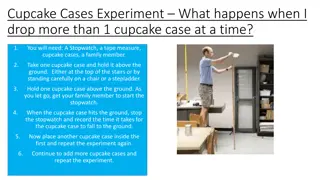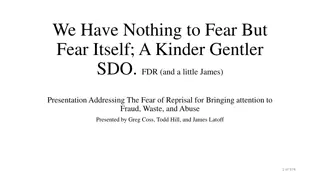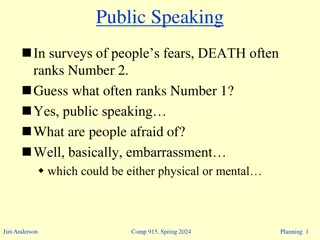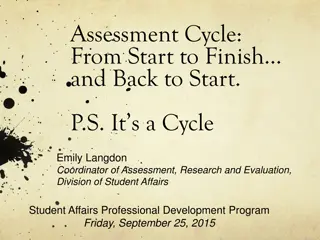Understanding Fear of Falling: Causes, Consequences, and Assessment
Fear of falling is a prevalent concern among older adults and individuals with certain health conditions. It can lead to negative outcomes such as increased risk of falls, activity avoidance, and decreased mental well-being. Factors contributing to fear of falling include perceived threat to balance, belief in the likelihood of harm from a fall, and previous fall experiences. Assessing fear of falling using tools like the Falls Efficacy Scale International (FES-I) can help healthcare professionals understand and address this issue effectively.
Download Presentation

Please find below an Image/Link to download the presentation.
The content on the website is provided AS IS for your information and personal use only. It may not be sold, licensed, or shared on other websites without obtaining consent from the author. Download presentation by click this link. If you encounter any issues during the download, it is possible that the publisher has removed the file from their server.
E N D
Presentation Transcript
Fear of Falling Consequences for Balance and Falls Dr. Toby Ellmers Sir Henry Wellcome Research Fellow Imperial College London t.ellmers@imperial.ac.uk
Key Take Home Messages 1. Fear of falling is worthy of attention 2. It can be maladaptive (with respect to balance and fall- risk), but not always 3. Perceived control is the key factor in whether fear of falling is ultimately maladaptive or adaptive 2
Fear of Falling: A Primer Highly common: - Experienced by up to 50% of older adults (Scheffer et al., 2008) - High levels also reported by people with Parkinson s Disease and who have experienced strokes (Peretz et al., 2006; Goh et al., 2016) Associated with a variety of negative outcomes: - Reduced mental wellbeing: increased depression, greater perceived vulnerability (Painter et al., 2012) - Activity avoidance deconditioning (Hadjistavropoulos et al., 2011) - Increase risk for future falls ? (Friedman et al., 2002) 3
Fear of Falling: A Primer Highly common: - Experienced by up to 50% of older adults (Scheffer et al., 2008) - High levels also reported by people with Parkinson s Disease and who have experienced strokes (Peretz et al., 2006; Goh et al., 2016) Associated with a variety of negative outcomes: - Reduced mental wellbeing: increased depression, greater perceived vulnerability (Painter et al., 2012) - Activity avoidance deconditioning (Hadjistavropoulos et al., 2011) - Increase risk for future falls ? (Friedman et al., 2002) 4
Fear of Falling: Causes What causes fear of falling? 1. The perception that balance is threatened 5
Fear of Falling: Causes What causes fear of falling? 1. The perception that balance is threatened AND 2. The belief that harm (a fall) is likely to occur What makes fear of falling more likely? A previous fall or near miss Recognition of balance limitations Vicarious experience (witnessing friends or family members having fallen) 6
Assessing Fear of Falling Falls Efficacy Scale International (FES-I): Easy to administer, highly reliable and most validated assessment Valid in a number of different contexts and populations For clinical purposes, we recommend the shorter 7-item version of the scale 7
Available free of charge in over thirty languages from www.fes-i.org 8
Other Ways to Assess Fear of Falling Single-item methods of assessment do also exist In general, are you afraid of falling? Not at all A little Quite a lot .. Very much IT IS CRUCIAL TO ALSO ASSESS BALANCE/PHYSICAL FALL RISK Positives: Quick and easy to administer Negatives: Less well validated, and provides less information about the nature of the fear 9
Fear of Falling and Falls A complex relationship: Early research suggested a clear and reciprocal relationship between fear of falling and falls (Friedman et al., 2002) However, recent research suggests a more complex relationship: High fear of falling increases fall-risk in individuals with good functional balance High fear of falling decreases fall-risk in individuals with bad functional balance(Litwin et al., 2018) 10
One of the Most Important Points of the Day Important to combine any assessment of fear of falling with a holistic assessment of balance and gait This will help put the level of fear into context Allow you to understand whether any fear are a realistic appraisal of fall-risk and likely to be protective Can also help identify over-confidence (Delbaere et al., 2010) 11
Fear of Falling and Falls: A Direct Link? Traditional conceptualisations suggested an indirect link: Fear of falling Poorer balance Deconditioning Falls But more recent conceptualisations suggest that fear of falling may directly reduce safety by disrupting balance and gait (Hadjistavropoulos et al. 2011; Young & Williams, 2015) How does fear of falling influence gait??? 12
Fear of Falling and Gait Fearful gait is More cautious reduced velocity, widened base of support, shorter steps, increased double-limb support (Delbaere et al., 2009) 13
Fear of Falling and Gait Fearful gait is More cautious reduced velocity, widened base of support, shorter steps, increased double-limb support (Delbaere et al., 2009) Stiffer and less fluid reduced joint movement and increased co-contraction of lower leg muscles (Brown et al., 2004) Consciously controlled and cognitively demanding (Gage et al., 2003; Holtzer, 2020; Ellmers & Young, 2018) 14
Fear of Falling and Gait Fearful gait is More cautious reduced velocity, widened base of support, shorter steps, increased double-limb support (Delbaere et al., 2009) Stiffer and less fluid reduced joint movement and increased co-contraction of lower leg muscles (Brown et al., 2004) Consciously controlled and cognitively demanding (Gage et al., 2003; Holtzer, 2020; Ellmers & Young, 2018) BUT ARE THESE CHANGES PROTECTIVE OR MALADAPTIVE??? 15
Fear of Falling and Gait Fear of falling may not be inherently detrimental to safety as long as it is proportionate to the threat faced/risk of falling Some level of fear may enhancesafety when balance is challenged or threatened (Ellmers et al., 2022) Likely explains why fear of falling may even have a protective effect for certain individuals(Litwin et al., 2018) However, problems arise when fear triggers unhelpful cognitive responses (e.g., worrisome thoughts and panic): Disrupts fearful gait adaptations Leads to gait adaptations that are excessive/unsuitable for the current context (i.e., overly-cautious gait) 16
High-Risk Patterns of Visual Search It has been suggested that fear of falling increases fall-risk by disrupting movement planning (Young & Williams, 2015) High-risk: Less proactive visual planning, instead freezing gaze towards the floor (Young et al., 2012) Causally associated with greater stepping errors and tripping These high-risk older adults also report fear of falling Could fear of falling be driving these unsafe behaviours? 17
24 low-risk and 20 high-risk participants completed an adaptive gait paradigm at ground level Trials completed whilst wearing a head mounted eye-tracker 18
Low-risk participants at Ground: No fear of falling and proactive visual search 19
High-risk participants at Ground: High fear of falling and restricted visual search 20
Low-risk participants also completed the protocol while raised 0.6m above the laboratory floor (no harness; Threat condition) 0.6m 21
Low-risk participants during Threat: Became fearful and also adopted Restricted visual search 0.6m 22
Ellmers, Cocks, & Young (2020) Restricted visual planning associated with significantly greater stepping errors But for high-risk only Low-risk participants adapted their behaviour to overcome the poorer planning So why were high-risk unable to adapt their movement? WHAT DIFFERENCES EXIST BETWEEN HIGH- AND LOW-RISK OLDER ADULTS? 23
High-risk older adults are more likely to worry/ruminate on past falls & consequences of falling (e.g., injury) when balance is threatened % Reporting worries/ruminations when fearful 80 % of Participants 60 40 20 0 Low-Risk High-Risk 24
Worries: A Maladaptive Cognitive Response? Could worries about falling be a key driver behind maladaptive behavioural responses when fearful of falling? 25
Worries: A Maladaptive Cognitive Response? Could worries about falling be a key driver behind maladaptive behavioural responses when fearful of falling? In-depth interviews with 17 community dwelling older adults who reported experiencing worries about falling Mean age = 79 years; 11 females, 6 males 10 participants lived alone, 6 lived with partner 9/16 had fallen in past 12 months Mean Falls Efficacy Scores indicated high levels of fear/concerns about falling 26
Theme 1 In control of being careful: Worries as a protector Worries viewed as helpful if preventing the worrisome fall is perceived as controllable I m still at the stage where if I concentrate and apply myself, I can avoid a fall Draw attention to threats Protective adjustments to behaviour reduced fear 27
Theme 2 Uncertain and out of control: Worries as a source of panic Worries viewed as unhelpful if preventing the worrisome fall perceived as outside of their locus of control Triggers persistent worries and panic: a really frightening feeling that everything s going to end Panic distracted them from adapting behaviour in useful ways Freeze and hesitate All this worrying stops me being able to focus on what I need to do when walking 28
Fear of Falling and Gait Fear of falling may not be inherently detrimental to safety as long as it is proportionate to the threat faced Some level of fear may enhancesafety when balance is challenged or threatened (Ellmers et al., 2022) Problems arise when Fear triggers unhelpful cognitive responses (strong, negatively-focused worries that persist during a task and lead to panic) Perceived control a strong driver of whether fear of falling has positive or negative consequences Supports previous research showing the importance of generalised perceived control (J nsd ttir & Ruthig, 2020; Kempen et al., 2003) 29
Key Recommendations Aiming to indiscriminately reduce fear of falling may do more harm than good; fear can be both protective and maladaptive Instead, clinicians should be aware of the key drivers responsible for the negative outcomes: Low perceived control Strong, negatively-focused worries that persist during a task and lead to panic Clinicians should only seek to directly target fear of falling itself in isolation if this is clearly excessive (e.g., an individual with high Falls Efficacy Scale scores but with limited/no balance problems) 33
The Updated Perceived Control over Falling (UP-COF) Scale Measuring of perceived control over falling Aim: Develop a questionnaire to be used in clinical settings to assess perceived control and associated panic/worries Modified and updated the existing (unvalidated) Perceived Control of Falling Scale (Lawrence et al., 1998) This involved focus groups with older adults and clinicians to refine existing items and create new items Created a new 6-item scale: The Perceived Control over Falling (UP- COF) Scale (Ellmers et al., In Prep) This was then validated (EFA) in a sample of 209 community dwelling older adults (mean age = 75.5; range = 60-90 years) Further refined resulting in a 4-item scale 34
(Exciting) Stats: Items loaded onto a single factor Good test-retest reliability (ICC = .718) Good internal consistency (Cronbach s alpha = .751) Moderate correlations with FES-I (r=-.567) and HADS-A (r=-.410) Confirmatory factor analysis still ongoing For a copy/to use the scale, email: t.ellmers@imperial.ac.uk
~20% of fearful participants meet this cut-off Cut off: Low perceived control = 13/20 (ROC analysis)
Key Take Home Messages Fear of falling leads to various changes in gait But these changes may not inherently detrimental to safety as long as they are proportionate to the threat faced and individuals feel in control Some level of fear may enhance safety when balance is challenged or threatened Problems arise when fear occurs with low perceived control and then triggers unhelpful cognitive responses (e.g., worrisome thoughts that lead to panic) 38
Questions? Thanks for listening! and thanks to the sponsors of this research Contact email: t.ellmers@imperial.ac.uk @Toby_Ellmers 39























